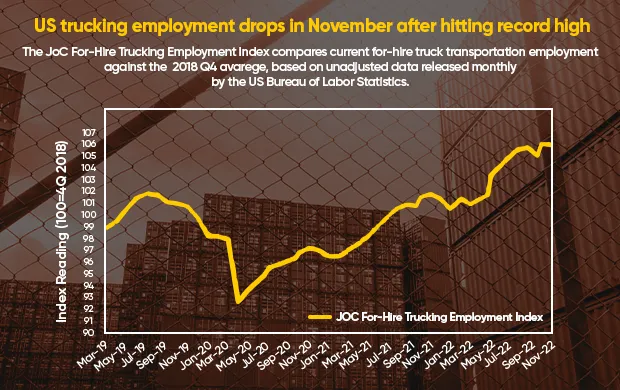The eastbound trans-Pacific trade in the next few months will face a “hard landing” marked by declining freight volumes and spot rates, with a recovery occurring by peak season 2023 at the earliest, according to Lars Jensen, CEO of consultancy Vespucci Maritime and a JOC analyst. In a more pessimistic scenario, that recovery may not take place until Lunar New Year 2024.
“In the very short term, expect a lot of blank sailings and service cancellations,” Jensen told a Journal of Commerce webcast Thursday.
Cargo volumes in October and November “fell off the cliff,” while at the same time vessel reliability in the Asia-North America trade improved, re-releasing capacity into the trade that had been effectively removed the past year when on-time vessel arrivals had fallen as low as 10 percent, Jensen said.
US imports from Asia declined 6.5 percent year over year in September and 11 percent in October, according to PIERS, a JOC.com sister product within S&P Global. With that, monthly cargo volumes have fallen not only below pre-pandemic levels, but also below 2018 levels, Jensen noted.
As of Nov. 28, carriers had scheduled blank sailings equal to 17.5 percent (479,442 TEU) of total trans-Pacific capacity for December and 6.2 percent (169,424 TEU) in January, compared with 25.3 percent (724,444 TEU) in December 2021 and 30.8 percent (899,163 TEU) in January 2022, according to Sea-Intelligence Maritime Analysis. However, carriers will likely skip more sailings during December and January than they have announced publicly; some sailings are canceled with no advance notice.
Not a rate war
Even though spot rates have dropped from a record high of $14,000 per FEU early this year, according to some rate indexes, to $2,000 per FEU now, Jensen said this does not mean a rate war is under way. “That’s a normalization of rates,” he said.
The average spot rate from Shanghai to Los Angeles this week was $2,039 per FEU, down 1 percent from last week and 79 percent year over year, according to the Drewry World Container Index. The Shanghai–New York spot rate was $4,408 per FEU, down 9 percent week over week and 65 percent year over year.
Spot rates spiked in late 2021 and early 2022 because demand far exceeded capacity in the trans-Pacific and dismal schedule reliability ate up as much as 14 percent of effective capacity in January 2021, Jensen said.
By October, carrier on-time performance had improved to 35.7 percent to the West Coast and 26.9 percent to the East Coast, according to Sea-Intelligence. As a result, only 6.7 percent of effective capacity remains unavailable, Jensen said. The recent re-release of capacity is taking place at the same time that cargo volumes are declining, and this hard landing will continue well into 2023, he said.
Still, it is impossible to predict how long it will take for retailers to complete their inventory correction and significantly increase their purchase orders with factories in Asia as high inflation and elevated interest rates limit consumer spending, Jensen said.
The supply side in the trans-Pacific also could be compromised if demonstrations in China over the government’s strict COVID-19 policies escalate and seriously impact productivity at factories and in the transportation sector there, he added.
As such, Jensen outlined two possible scenarios. In the “optimistic” scenario, the US will experience a short, shallow recession that ends by next summer, with demand returning strongly for the traditional peak season and no major wildcards affecting the trade. In the more “pessimistic” scenario, the recession is deeper and lasts longer than some economists are forecasting, which means strong import growth will not return until after the Lunar New Year in 2024, Jensen said.
“Right now, it is impossible to predict when [the next cargo surge] is going to happen,” Jensen said.
Source: JOC

